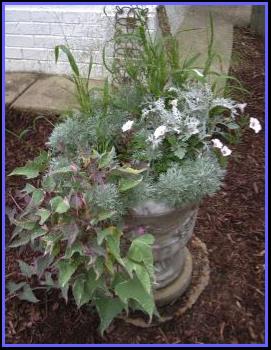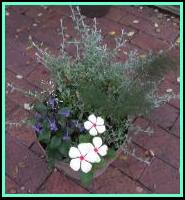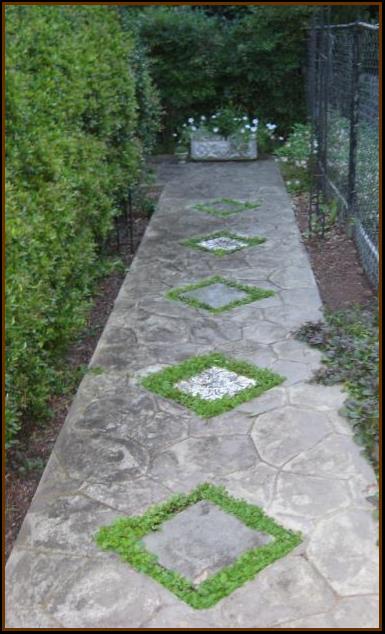|
Laurie’s home is full of what she calls ”fake antiques“ and this has carried over into her garden. ”On a single, self-employed artist’s budget I can’t afford all the beautiful fountains, old-world statuary, brickwork, architectural antiques and garden furniture to which I am drawn,“ she states. ”I love all things old and since I can’t always have the real thing, I fake my patina!“ Below and left is a dollar-store bench she purchased for $40. With a little paint and a thrift store lovebird appliqué attached to the back, it was transformed into the ”old“ garden antique on the right below! |
|
At left is the view as you enter Laurie Parker’s backyard garden, a work in progress (this photo taken 2012). The single, self-employed artist/writer bought her first house in 2008 and began her garden in 2010. Other than hiring someone to sod (there was no grass) and hiring a company to do a few hardscaping projects (according to her design layout), Parker has done everything you see in the photos HERSELF. That includes creating all of the beds, hauling tons of dirt to build berms, rolling 25-inch diameter round stepping stones to move them from the front yard to the back, crawling on her belly to access and clear out a ditch that was 5-feet high in vines and backed-up pine straw. The yard had no beds when she moved in, and has some major issues with what basically amounts to a creek running through it in heavy rain. But she has worked hard to make lemons out of lemonade (and dig ditches HERSELF where there were none—to redirect the rapids which come ripping through during heavy rain). |
|
THE DESIGN IS ALL HERS!!! As an artist, GARDEN DESIGN is probably her favorite part of gardening. She also enjoys the challenge of camouflaging or converting eyesores and ”things that had been totally let go“ into something attractive or interesting. Case in point, she has turned a corner of huge overgrown elaeagnus and holly into what she calls ”the cove“ She also thrives on using found objects in her garden. She used 2 by 4’s she discovered buried in a jungle-like corner, along with branches from heavy pruning of privet (yes—the property has a lot of the invasive ”hedge“) to create the arched doorway into the cove, shown below. She hauled all the gravel for the path into herself. A young Schizophragma (False Climbing Hydrangea) climbs on the arch and will hopefully cover it eventually… To the right is the cove entrance as viewed from a distance through native white Baptisia (one of her very favorite plants in her garden!) |
|
Another example of Laurie’s converting trash to treasure is the fountain in the parterre bed outside her bedroom window (just below bench photos). The bed is her asparagus bed. To its left are encore azaleas. One of two kinds of spirea in a mixed hedge she grew from cuttings is finishing up its blooming in the background (just above the bowl). You can also see a side view of the living arch she made by pleaching two altheas (above the lavender-colored bearded irises farthest to the left). Although not seen here, annuals such as Angelonia and self-sown Cleome are planted amongst the asparagus. She ”encourages“ the asparagus foliage to fall to the ground and also trims it some in the summer so that it doesn’t hide the view of the fountain too badly. The fountain is made from an old fiberglass fire pit one of her mom’s neighbors had thrown out on the side of the road AND a fire bowl her own neighbor had thrown out! She did a little painting on it, and with an inexpensive garden statue atop, and a solar pump—voila! |
|
Laurie has also faked it with this ”secret garden door“ (left). She bought a large piece of foam board with the determination that she could use it to create what looked like an old, weathered door. ”One night around 11:00 pm, I decided to get out in the garage and cut out the basic shape,“ she says. ”I used a round card table that was handy to trace the top part. It ended up being easy to cut out with a knife and I used the knife to carve out the grooves between the ’boards.‘ I dug through the drawer where I throw all kinds of miscellaneous items that I think can be re-purposed and lo and behold, some old discarded plastic easels I bought for art shows ages ago looked perfect as faux hinges when I opened them all the way out. A neighbor friend gave me an old rusty door handle from her shed. I waterproofed it all and attached to a T-stand and put it against my eleagnus...as a suggestion that there is ’more beyond.‘ “ |
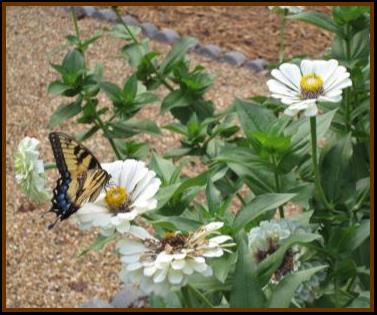
|
Laurie does not like red, fuchsia, orange, bright yellow or any hot colors. ”I like lots of green foliage, white, and gray/silver plants—like lamb’s ears, Artemisia, curry plant, etc. I do a little purple, and some pale pink and pale yellow. A little burgundy foliage is okay. But I mostly like LOTS of evergreens and all white flowers. I find that palette the most serene.“ Back in the summer of 2010, Parker had a whole bed that was all white zinnias and says she was amazed at how many butterflies (below) and even hummingbirds flocked to the white flowers, as she thought hummingbirds favored red. To the left is a heuchera (she LOVES the foliage) and an azalea in bloom (in white, of course). Below that on the left is variegated potato vine spilling from an urn (which began with all cuttings). |
|
Click here for more on Author/Artist Laurie Parker |
|
GARDEN ALPHABET |

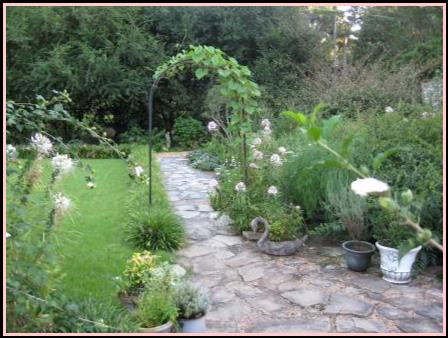
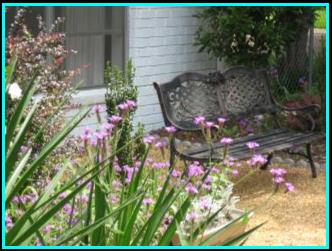
|
Above, you can see a homemade moss ball set amongst holly ferns and hostas. Laurie made it on a child’s ball that she covered with glue, dirt, and moss from her yard. The pretty blooms above it are that of common, TREE-SIZE privet... Yikes! But the smell is divine! |
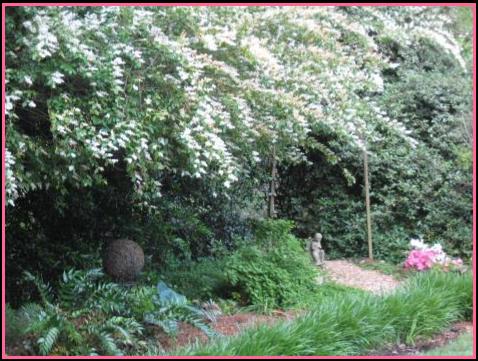
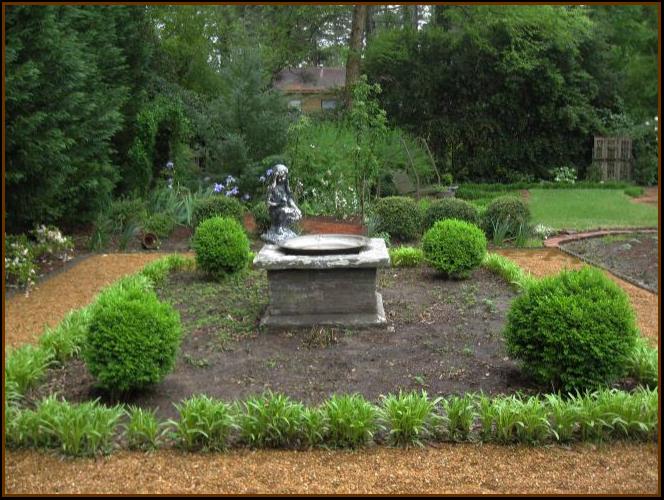
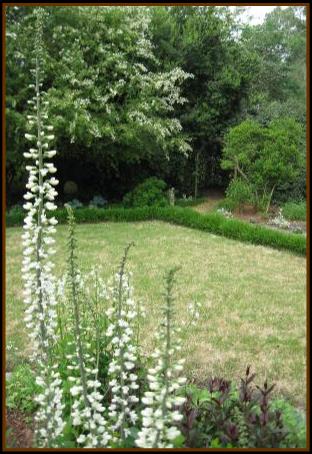
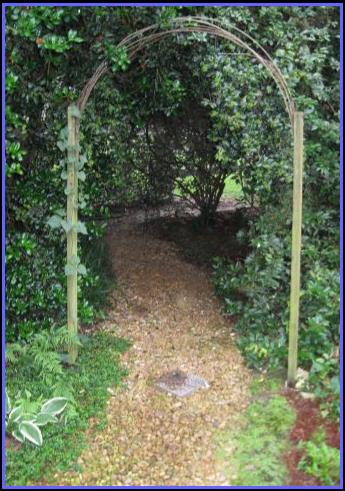
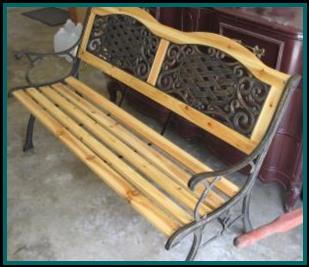
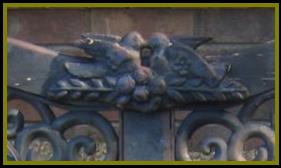
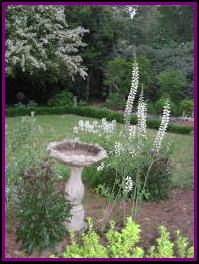
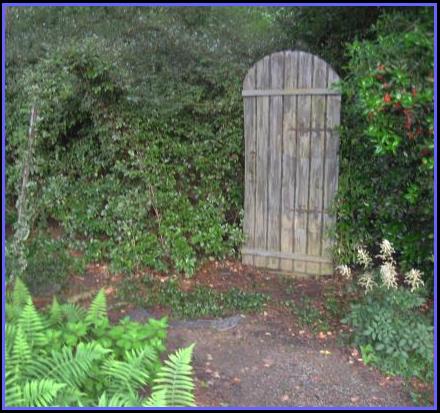
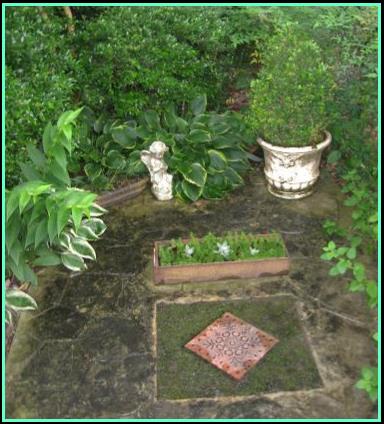
|
Parker said the men who did her concrete work (shown at right) thought she was crazy when they poured a concrete walk and she requested that they build square frames and insert them in a row and then remove after the hardening, leaving square openings. ”One of the guys told me he thought I was going to just leave these big square holes for people to trip on,“ she laughs. ”Once I inserted a smaller square paver, some soil, and moss, they finally understood my ’diamond walk‘ (right). Since then I have filled them in with dichondra (as in the weed) that I pulled from flower beds. It makes a good green filler, and there is an endless supply!“ The ajuga growing on the right will eventually spread all the way down, and more has been sprigged on the left side as well. When you walk to the end and hang a left, you see the little niche shown below. ”I know NANDINA is considered ’common‘ and/or old-fashioned,“ she admits, ”But there was a lot of it scattered here and there on the property, and I am big on using existing plants and materials! Plus, it is so easy! Easy to transplant and low maintenance. It was the perfect screen to cover the ugly chain-link fence beside this area. There is an oakleaf hygrangea coming up that doesn’t really show in the photo, elderberry behind it, hostas, and an old metal drawer filled with sedum and hens and chicks. The volunteer lemon balm growing here is okay because it is contained by concrete. And moss is growing around the decorative metal piece in a depression I made in the concrete when the guys poured it.“ |
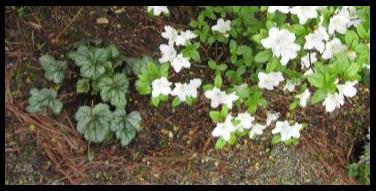
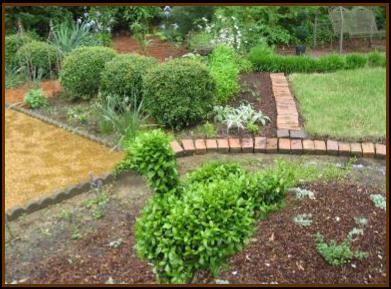
|
”ANOTHER WRITER’S GARDEN“ Scenes from the real garden of Laurie Parker, author/illustrator of Garden Alphabet |
|
Laurie loves topiaries and standards. She clipped the fat bird from a holly (that you see on the left) herself. The bed below him is slowly filling in with recently-transplanted silver mound Artemisia. To the right is a wall sun that Laurie made—from a plastic garbage-can lid and foam! |
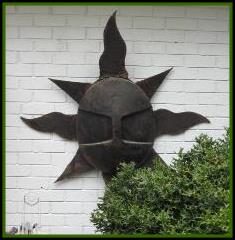
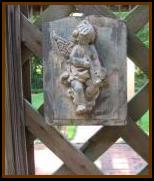
|
Above, a thrift store cherub was glued onto a thrift store plaque to create a new “old” plaque. Below, a pot with helichrysum, bronze fennel, cascade vinca (from a cutting) and plectranthus (also a cutting—of “Mona Lavender”) |
